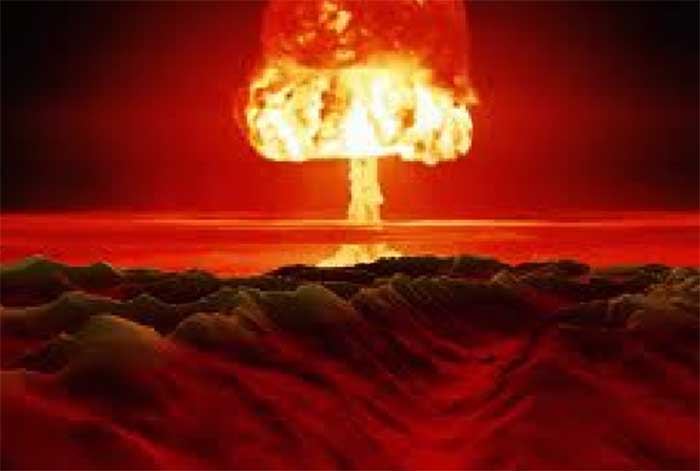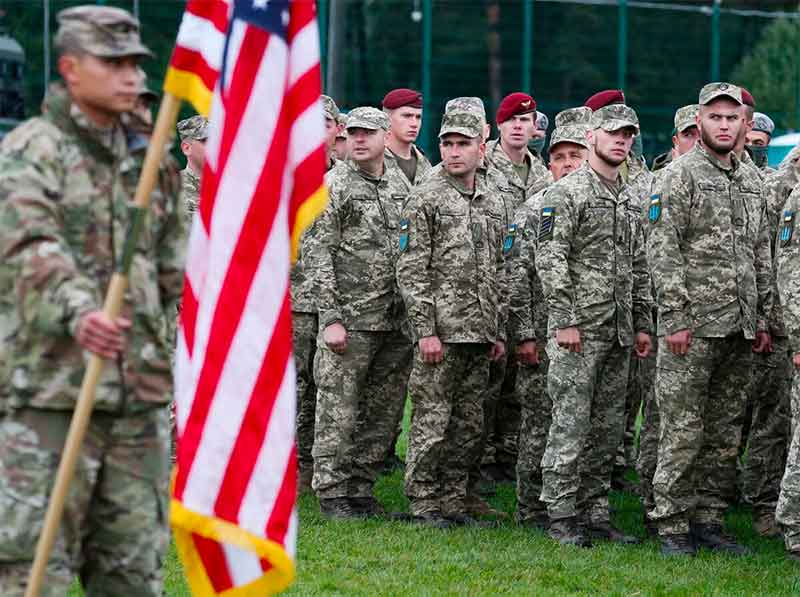
“I liked history better when it was in the past.”
There are several implications of this kind of statement. For people living in benign territories, ones that are not subject to corporate or military subjugation, history is the past, the written record of what has happened while life continues on its usual path. For others history is what is occurring at the moment – as it truly is everywhere – when certain events take on a significance beyond the usual military-political manipulations of events and their perception.
When it is taken in context with current events, it implies something even more difficult to perceive: if World War III does occur, it will truly be the end of history. There will be no one remaining to be able to write down the events that happened to their predecessors as all civilizational features allowing history – the recording of events – will be gone, regardless of whether a few indigenous people manage to survive in some remote parts of the world.
The normalization of nuclear war.
In our modern society war has been an ongoing and continuous event, advancing in technological finesse and increasingly deadly weaponry. It is the normalization of nuclear power, nuclear war, that continually hangs over the world, threatening its continued existence. Up until a week or so ago, discussion of nuclear war was mostly background noise – it has been discussed since the advent of the first atomic bombings of Japan, it has been close before but mostly undisclosed at the time by the powers that be.
The boomer generation in some countries remembers the “duck and cover” school drills which when considered in the reality of the weapon were more a propaganda infusion than a rational means to survive a nuclear attack. Others were tempted into building nuclear shelters, in the vain thought that somehow if they could survive for a week or a month then the survivors would pick up the pieces and the world would continue on its way. After those two aspects died out in following generations, while nuclear war could always happen, it faded into the background of everyday life and its triumphs and tribulations.
Religion has played its part in this normalization. The evangelical movement in the U.S. appears to look forward to a nuclear armageddon to satisfy their interpretation of biblical prophecy. Israel’s nuclear weapons are an option in a first strike perspective in particular against Iran, but would herald the end of times as well, creating a masada complex weirdly under the ‘never again’ philosophy of modern Judaism. In South Asia, Pakistan and India, Muslim versus Hindu, face off with each other – along their common border and in Kashmir – with nuclear weapons, created and aided and abetted by a host of other countries.
It may have faded into the background for the average citizen, but for the military the concept of nuclear war never faded but became increasingly stronger. The Cold War contest between the U.S. and Soviet Union produced huge increases in nuclear armaments, progressing from those delivered by plane to those delivered by ballistic missiles to those delivered by stealth bombers, drones, and guided missiles.
The worst aspect of a discussion of nuclear war is secular: the U.S.’ official position of first strike nuclear use, of using a nuclear attack to start a war and believe that the ‘west’ could survive it, could declare themselves victors, and history would continue. That perspective has been held by the U.S. military from the start.
The atomic bombing of Japan was unnecessary and is generally considered to have been done as a statement against the Soviet Union. Once the Soviets created their own weapon, U.S. propaganda went into full gear for the arms race, always arguing about a ‘missile gap’ which under historical review always favored the U.S. There have always been plans for the U.S. to initiate a first strike nuclear war against both China and the Soviet Union and the world would be foolish to think similar plans do not still exist. With the likes of Paul Wolfowitz and his cadre of neocons and the warlike fantasies of John Bolton the U.S. administration is not adverse to the use of nuclear weapons.
No survivors
What prompted this essay were comments by an online commentator, “Beau of the Fifth Column” [1] who for the most part has very well considered presentations on diverse topics within U.S. politics, usually domestic, but increasingly and obviously now with foreign affairs. He had one presentation which discussed how to survive a nuclear attack prompted by questions received after Russia announced its nuclear alert – which for its limited range of discussion was good, but did not address the reality of a much larger context [2]. To his credit he started with a caveat saying at any given time in modern times, both nuclear forces have been at high alert for launch. His discussion centered on surviving one nuclear bomb, not in the usual metrics of measured distance from ground zero but by whether it was ‘felt’ or ‘seen’.
Without going into the details of his argument, which within his limited scope were reasonable, the larger context was missing. In simple terms the larger context is that if one bomb is going off where you can feel and see it – and survive – there are several hundreds of others if not thousands going off around the world at the same time, give or take a half hour.
Within that context, yes, perhaps an individual, maybe hundreds in any given large urban area, might survive but long term survivability has to consider other factors. As mentioned it would not just be one bomb: with thousands of warheads available most would be launched on first command. Several can be targeted at individual larger centers and larger military bases to ensure survivability of the attacking missiles and completeness of the attack. The ramifications should then be obvious.
All power would be off. Modern technology would be gone, either from lack of power or from the electromagnetic pulses. Medical services would not exist, and certainly not for the trauma scale required to help survivors. Emergency services of other kinds would not exist. There would be no running water, no electricity, transportation routes into and out of bombed areas would not exist. Food resources would not be available. But just pretend that given all that, a person could survive for a week or two or a month in some kind of shelter, living inside while the radiation levels outside supposedly dropped to survivable levels. Two other major factors come into play.
Nuclear winter…
Scientists have long warned about the consequences of a nuclear war and its effects on the environment. Most commonly known of these is the concept of nuclear winter.
With the massive explosions and resultant fires huge amounts of ash, dust, and aerosols would be lifted high into the atmosphere and spread over the full range of the globe. With even a limited hypothesized nuclear war – usually argued as being between Pakistan and India – there would be enough ash and aerosols to create a nuclear winter. With the whole world involved it would be inevitable that there would be a few years of nuclear winter the main result of which would be the loss of agricultural production.
Having survived the original blast, any survivors would face severe long term obstacles in obtaining food. Corporate agriculture would be gone: fertilizer production would not exist, machines would not be repairable and largely without fuel, transportation of any surviving produce would not be possible, refrigeration and storage facilities would be inoperable. Local agriculture would depend on the variables of cold weather, lack of seed supplies, limited manpower, and the highly irradiated environment.
…and irradiated earth
The latter point is one that is generally ignored in arguments about nuclear war, but is sometimes included with those arguing about climate change in general. There are some 400+ nuclear reactors around the world – most of these are in Europe (including Russia) and the eastern U.S. with others located mainly in East Asia (China, Korea, Japan) and in India/Pakistan. These reactors require power and water in order to operate properly and while designed to be able to operate in certain adverse conditions they are highly susceptible to extreme damage without power to run the cooling systems and spent fuel storage areas.
In a nuclear war, these facilities might be targeted directly, but even if not, they would be without power from the regular power grid and after a short period any emergency backup facilities would run out of fuel, and depending on access, lose all their water requirements. Beyond that would be a lack of technical expertise to continue operating and repairing the facilities and no services would be able for long term monitoring of the sites.
Several large scale nuclear accidents give clear signals as to what to expect. In the Soviet Union, a major explosion in Chelyabinsk (1957) contaminated two dozen villages and large areas of land. Chernobyl in north-central Ukraine experienced a meltdown (1986) contaminating local land and lands as far away as Scotland. A major earthquake off Fukushima resulted in the meltdown of three nuclear cores (2011) at the Daiichi power station. Neither Chernobyl nor Fukushima have been cleaned up and still pose major long term risks to the environment and people working on or nearby the plants. In the U.S. the Three Mile Island plant suffered a ‘partial’ meltdown (1979) resulting in large radiation release and structural damage to the power plant.
In all these cases, official reports have downplayed the number of people killed in the incidents. The immediate death toll may have been low, but the ongoing lingering radioactivity will take centuries/millennia to disperse. At Fukushima in particular, the nature and status of the melted cores is essentially unknown and the radioactivity is so high it destroys technical efforts used to find and observe the destruction.
In short, after a nuclear war and all its direct and concomitant damage and effects, there would be a highly probable several hundred Fukushimas around the world, spilling out endless amounts of radiation for centuries.
No nukes
If all that sounds scary, good, it should have that reaction. Surviving a nuclear war is a short term action and in the long term virtually improbable.
Given that the world survives the current crisis, it needs to become mandatory to restrict and eliminate nuclear weapons from the world. Regardless of the widespread official acceptance of the Nuclear Nonproliferation Treaty, there has been no serious governmental attempts to eliminate nuclear weapons stockpiles and neither has there been any serious attempt to limit their spread – only the unwillingness of many countries to develop them has prevented a more widespread distribution.
Having become normalized, it becomes imperative to denormalize nuclear weapons and nuclear power plants. The militaries of the world will not do so alone, nor will they do so unilaterally.
While the world remains on the brink of nuclear destruction, a fate we have escaped so far mostly through luck combined with a small touch of intelligence, no one should be resting easy about the future of their children and grand-children. Hopefully they will have a history to read about that remains in the past and is not a series of ongoing current events’ crises continually threatening their survival.
[1] https://www.youtube.com/channel/UC0YvoAYGgdOfySQSLcxtu1w
[2][https://www.youtube.com/watch?v=ox8ZDbCNTCE]
Jim Miles is a Canadian educator
















































